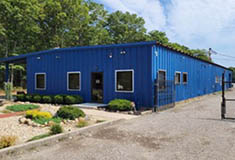The COVID-19 pandemic will have long-lasting implications on commercial real estate’s future - by Michael Murphy

The world has changed dramatically since the Coronavirus outbreak, and real estate markets have not escaped its impact. The pandemic has magnified and accelerated a number of sector trends for the longer term. Even in a post-pandemic world, it is widely accepted that many of the new practices, such as increased remote working and greater e-commerce, will continue to be observed. While the COVID-19 pandemic will have long-lasting implications on the future of commercial real estate which are difficult to predict, the pandemic has had an unparalleled impact on the way we live and work. These changes have forced property owners to rethink and adapt their properties during the immediate recovery to take into account health concerns, social distancing requirements, safety protocols and mass remote working, all at the same time.
Three core commercial property sub-sectors and how they might be affected by the recent changes in how we live and work in 2021 are:
Retail
The pandemic meant a sudden and disastrous hit for retailers in cities around the world who were forced to shut down, halting their revenues, while many costs remained. This resulted in some well-known names entering administration: J. Crew, J.C. Penney, Victoria’s Secret, Sears, and several known restaurant chains, just to name a few. In the U.S., there is a sad tradition of retail parks and malls being abandoned if they are not making money or cost too much to refurbish. The impact of Coronavirus could also see this trend increase. The pandemic has shifted focus onto the relationship between retailers and property owners, and this needs to be urgently addressed if we are to avoid long-lasting damage to malls and high streets. This may mean repurposing the space—as has been done with some malls in the U.S., which have been converted into tech company headquarters, churches, libraries or even community spaces.
Warehouses and Industrial
The rapid global shift to e-commerce caused by the pandemic has seen warehouse and industrial markets receive a timely boost. E-commerce increases demand for space because online retailers must stock a wider variety of products to match consumer demand. Amazon reported a 26% year-over-year increase in sales in the first month of lockdown. It has taken decades for online shopping to claim a double-digit share of retail spending. The e-commerce share is now as high as 40%, with statewide lockdowns rapidly accelerating the shift. Consumers who realized the benefit and convenience of e-commerce during the pandemic may not be rushing back to the high street any time soon.
Office Space
A gradual shift in working patterns before COVID-19 meant we were already seeing fewer and fewer companies looking for traditional long leases, opting for more flexible working space. As a result, co-working space providers have surged in recent years. Now, many commentators are heralding the success of remote working during the pandemic as the dawn of a new work-from-home revolution. This may be far-fetched, but the need for office space and the accompanying large overheads will undoubtedly be questioned by businesses that managed simply fine with remote-working staff. The property industry is all about people, and apps such as Microsoft Teams, which, while incredibly useful, do not provide face-to-face contact. As things slowly creep back toward a semblance of normality, we will likely see a mix of new and old. Companies will be looking to keep some office space, but perhaps reduce the size as they allow for more remote and flexible working. Firms may look for buildings where they can better control the environment and ensure the well-being of their workforce—in some cases expanding space to allow for greater social distancing within the office.
Silver Lining
It will be an opportunistic market and transactional! Amid what may appear as a dismal outlook for commercial real estate, there are still plenty of opportunities. For one, the industry was in a better position at the start of the pandemic than the last recession in 2008-09. Before the world knew about COVID-19, the majority of real estate executives forecasted more capital growth in 2020, and debt positions were strong.
The industrial market was on the rise pre-pandemic, too, and opportunities remain in that sector. Grocery stores, warehouses, and e-commerce growth are keeping the demand for industrial building renovations and new construction.
Another way that real estate leaders can thrive in this changing economy is by adapting existing spaces. Even before COVID-19, landlords of retail spaces had to explore options in adaptive reuse. Alternatives to empty storefronts can include pop-up retail, cultural or entertainment spaces, co-working space, self-storage, or medical office space, to name a few. Some larger retailers started using closed stores as online fulfillment centers, and some restaurants shifted to grocery pick-up.
No matter what the future holds for CRE, there will always be room for physical real estate. It is hard to build a company culture or have the same experiences with shopping, dining, or connecting with other people strictly online! Commercial real estate is in flux, and opportunities to innovate are emerging.
For now, I remain optimistic about a return to business as usual, particularly within the Long Island market.
It feels like things can go wrong really fast in the Long Island commercial market, but typically they bounce back really fast, too!
Michael Murphy is executive vice president/head of operations at Douglas Elliman Real Estate, Commercial Services, Huntington, N.Y.
Suffolk County IDA supports expansion of A&Z Pharmaceuticals


The evolving relationship of environmental consultants and the lending community - by Chuck Merritt
When Environmental Site Assessments (ESA) were first part of commercial real estate risk management, it was the lenders driving this requirement. When a borrower wanted a loan on a property, banks would utilize a list of “Approved Consultants” to order the report on both refinances and purchases.








.gif)
.jpg)